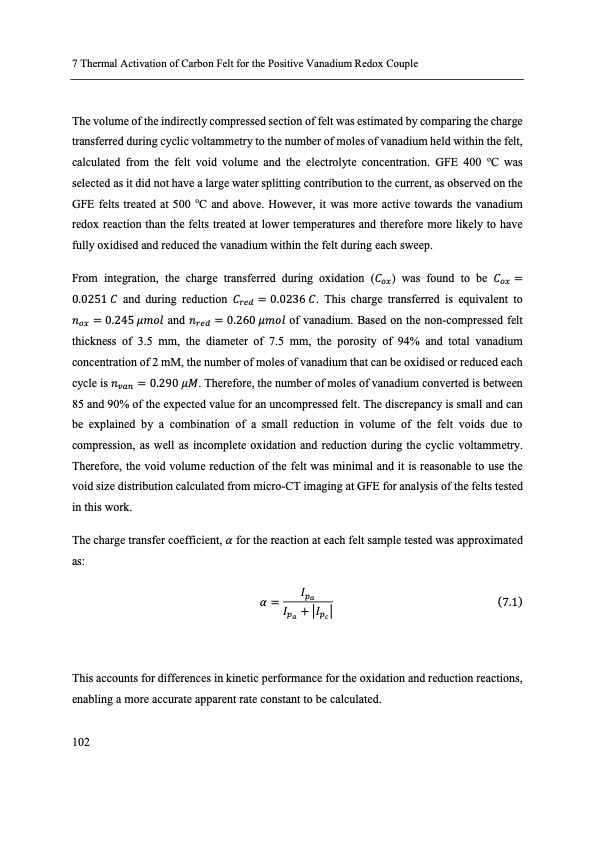
PDF Publication Title:
Text from PDF Page: 114
7 Thermal Activation of Carbon Felt for the Positive Vanadium Redox Couple The volume of the indirectly compressed section of felt was estimated by comparing the charge transferred during cyclic voltammetry to the number of moles of vanadium held within the felt, calculated from the felt void volume and the electrolyte concentration. GFE 400 oC was selected as it did not have a large water splitting contribution to the current, as observed on the GFE felts treated at 500 oC and above. However, it was more active towards the vanadium redox reaction than the felts treated at lower temperatures and therefore more likely to have fully oxidised and reduced the vanadium within the felt during each sweep. From integration, the charge transferred during oxidation (𝐶𝑜𝑥) was found to be 𝐶𝑜𝑥 = 0.0251 𝐶 and during reduction 𝐶𝑟𝑒𝑑 = 0.0236 𝐶. This charge transferred is equivalent to 𝑛𝑜𝑥 = 0.245 𝜇𝑚𝑜𝑙 and 𝑛𝑟𝑒𝑑 = 0.260 𝜇𝑚𝑜𝑙 of vanadium. Based on the non-compressed felt thickness of 3.5 mm, the diameter of 7.5 mm, the porosity of 94% and total vanadium concentration of 2 mM, the number of moles of vanadium that can be oxidised or reduced each cycle is 𝑛𝑣𝑎𝑛 = 0.290 𝜇𝑀. Therefore, the number of moles of vanadium converted is between 85 and 90% of the expected value for an uncompressed felt. The discrepancy is small and can be explained by a combination of a small reduction in volume of the felt voids due to compression, as well as incomplete oxidation and reduction during the cyclic voltammetry. Therefore, the void volume reduction of the felt was minimal and it is reasonable to use the void size distribution calculated from micro-CT imaging at GFE for analysis of the felts tested in this work. The charge transfer coefficient, 𝛼 for the reaction at each felt sample tested was approximated as: 𝛼= 𝐼𝑝𝑎 (7.1) 𝐼𝑝𝑎 +|𝐼𝑝𝑐| This accounts for differences in kinetic performance for the oxidation and reduction reactions, enabling a more accurate apparent rate constant to be calculated. 102PDF Image | Electron Transfer Kinetics in Redox Flow Batteries

PDF Search Title:
Electron Transfer Kinetics in Redox Flow BatteriesOriginal File Name Searched:
electron-transfer-flow-batteries-thesis.pdfDIY PDF Search: Google It | Yahoo | Bing
Salgenx Redox Flow Battery Technology: Salt water flow battery technology with low cost and great energy density that can be used for power storage and thermal storage. Let us de-risk your production using our license. Our aqueous flow battery is less cost than Tesla Megapack and available faster. Redox flow battery. No membrane needed like with Vanadium, or Bromine. Salgenx flow battery
| CONTACT TEL: 608-238-6001 Email: greg@salgenx.com | RSS | AMP |